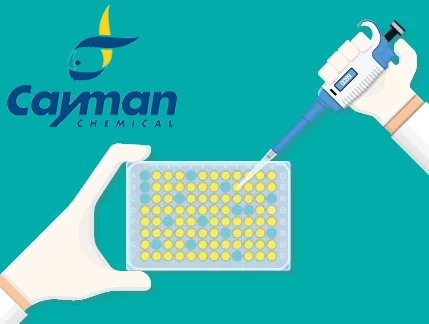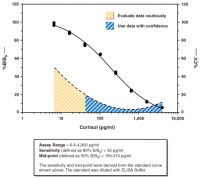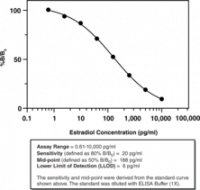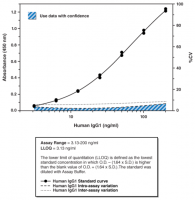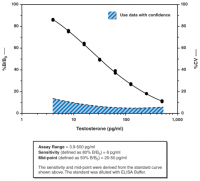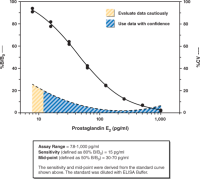Original article by Cayman Chemical
These topics await you:
5) Citrullinated Histone H3 (Clone 11D3) ELISA Kit
8) Human Therapeutic IgG1 ELISA Kit
9) Prostaglandin E2 ELISA Kit – Monoclonal
11) Benefits of Cayman ELISA Kits
Subscribe to the free Biomol newsletter and never miss a blog article again!
Whether you are looking for a new angle in your research or are just curious, discover the top 10 most popular ELISAs by our partner Cayman Chemical in this article. Steroid hormone ELISAs populate the majority of this list, followed closely by ELISAs for lipid metabolites and cyclic nucleotide second messengers.
In alphabetical order, they are:
2'3'-cGAMP ELISA Kit
2'3'-cGAMP is a second messenger produced from ATP and GTP by cyclic GMP-AMP synthase (cGAS) in the cytoplasm of mammalian cells in response to the presence of dsDNA [1-3]. It contains a non-canonical 2'5'-phosphodiester bond and binds tightly to the adapter protein STING (stimulator of interferon genes), resulting in IRF3 phosphorylation and the production of type I interferons [3, 4]. Activation of cGAS and the production of 2'3'-cGAMP are important in host defense but also may play role in autoimmune or inflammatory diseases [5].
Take a glance at the features of the 3'3'-cGAMP ELISA here.
Related items: 3'3'-cGAMP ELISA Kit, Cyclic di-AMP ELISA Kit, Cyclic di-GMP ELISA Kit
8-Isoprostane ELISA Kit
8-Isoprostane is produced by the non-enzymatic peroxidation of arachidonic acid in membrane phospholipids [6, 7]. 8-Isoprostane is present in human plasma and urine and levels increase with age and under conditions of oxidative stress [6, 8].
Related items: TBARS Assay Kit, Lipid Hydroperoxide (LPO) Assay Kit, Superoxide Dismutase Assay Kit, 8-Isoprostane Express ELISA Kit, STAT-8-Isoprostane ELISA Kit, 8-Isoprostane Affinity Purification Kit
Corticosterone ELISA Kit
Corticosterone is a steroid hormone produced by the adrenal cortex in response to stress [9]. The production of glucocorticoids is increased in stress, and corticosterone is frequently measured as an indicator of stress.
Related items: Aldosterone ELISA Kit
Cortisol ELISA Kit
Cortisol is a glucocorticoid produced by the adrenal cortex in response to adrenocorticotropic hormone (ACTH) [10]. Cortisol is secreted in a circadian manner and peaks just prior to waking in the morning. Cortisol levels increase with age and are often elevated in various disease states, including major depressive disorder, certain forms of hypertension, and AIDS [11-13]. Cortisol also promotes adipocyte differentiation [14, 15].
Related items: 11-Oxoetiocholanolone ELISA Kit, Cortisol Express ELISA Kit
Citrullinated Histone H3 (Clone 11D3) ELISA Kit
Histone H3 is citrullinated by PAD4 during epigenetic chromatin remodeling and neutrophil extracellular trap (NET) formation [16-19]. Failure to clear citrullinated proteins and NET components can result in autoantibodies and anti-citrullinated protein antibodies, which are associated with several human diseases including rheumatoid arthritis, systemic lupus erythematosus, Alzheimer's disease, and multiple sclerosis [20]. Citrullinated histone H3 can also be used as a functional readout of pharmacological PAD inhibition.
Related items: PAD4 (human) ELISA Kit, PAD4 Autoantibody ELISA Kit, PAD4 Inhibitor Screening Assay Kit (AMC), NETosis Assay Kit, NETosis Imaging Assay Kit
Cyclic GMP ELISA Kit
Guanosine 3',5'-cyclic monophosphate (cyclic GMP or cGMP) is a key intracellular second messenger that transduces cellular signaling events to cGMP-gated channels, cGMP-dependent kinases, and cGMP-regulated phosphodiesterases in response to a variety of hormones, autacoids, and drugs [21, 22]. The relative abundance of cGMP within a given cell can serve as a marker for activation by agonists acting through particulate guanylate cyclase at the cell surface or intracellular activation of soluble guanylate cyclase by nitric oxide [23, 24].
Related items: Cyclic AMP ELISA Kit
Estradiol ELISA Kit
Estradiol is a steroid hormone produced from testosterone via the aromatase system in the granulosa cells of ovarian follicles [25, 26]. It is instrumental in the development of secondary sex characteristics at puberty and in the menstrual cycle [27-29]. Estradiol is metabolized into estrone by 17β-hydroxysteroid dehydrogenase 2 and hydroxylated metabolites such as estriol, as well as glucuronidated and sulfonated metabolites, which are excreted in the urine and feces [30].
Related items: Estrone-3-Glucuronide ELISA Kit, 2-Methoxyestradiol ELISA Kit, Estriol ELISA Kit, Progesterone ELISA Kit
Human Therapeutic IgG1 ELISA Kit
Cayman's Human Therapeutic IgG1 ELISA Kit distinguishes experimentally introduced human IgG from endogenous monkey IgG for use in the pharmacokinetic analysis of therapeutic human antibodies in monkeys.
Related items: Human Therapeutic IgG2 ELISA Kit, Human Therapeutic IgG4 ELISA Kit, Mouse IgG ELISA Kit
Prostaglandin E2 ELISA Kit – Monoclonal
Prostaglandin E2 (PGE2) is an eicosanoid formed by COX-mediated metabolism of arachidonic acid [31]. The effects of PGE2 are mediated by at least four distinct receptors designated EP1, EP2, EP3, and EP4. PGE2 has diverse roles in inflammation, immune modulation, preservation of renal and bone homeostasis, gastric mucosal integrity, fertility, and parturition [32-35].
Related items: Prostaglandin Screening ELISA Kit, Prostaglandin E Metabolite ELISA Kit, Prostaglandin E2 Express ELISA Kit
Testosterone ELISA Kit
Testosterone is the primary androgenic steroid in mammals [36]. It plays a major role in the growth and function of many reproductive and non-reproductive tissues and organs including muscle, liver, and brain, directing the development of the male phenotype during embryogenesis and at puberty.
Related items: 11-keto Testosterone ELISA Kit, Testosterone Glucuronide ELISA Kit
All ELISA Kits by Cayman Chemical
Benefits of Cayman ELISA Kits
Our colleagues at Cayman Chemical have an exceptional understanding of ELISA development, validation, and performance based on decades of experience in commercial assay kit development and manufacturing. At Cayman, they understand that the performance of an ELISA is dependent on more than antibody selection. While proper antibodies are the foundation of a dependable ELISA, other reagents like wash buffers, diluents, and blocking reagents can influence the assay performance and cannot be taken lightly.

The Cayman Chemical ELISAs are provided as complete kits that include all necessary reagents, plates, and protocols, saving you valuable time and resources and helping you get fast, accurate results. Each ELISA undergoes rigorous optimization, quality control, and validation prior to release. Cayman's attention to these details and adherence to industry-standard best practices ensures you will obtain accurate and reproducible results, from day to day and lot to lot.
Learn more about why researchers trust Cayman assays
Sources
[1] Wu, J., Sun, L., Chen, X., et al. Cyclic GMP-AMP is an endogenous second messenger in innate immune signaling by cytosolic DNA. Science 339(6121), 826-830 (2013).
[2] Sun, L., Wu, J., Du, F., et al. Cyclic GMP-AMP synthase is a cytosolic DNA sensor that activates the type I interferon pathway. Science 339(6121), 786-791 (2013).
[3] Zhang, X., Shi, H., Wu, J., et al. Cyclic GMP-AMP containing mixed phosphodiester linkages is an endogenous high-affinity ligand for STING. Mol. Cell 51(2), 226-235 (2013).
[4] Hall, J., Brault, A., Vincent, F., et al. Discovery of PF-06928215 as a high affinity inhibitor of cGAS enabled by novel fluorescence polarization assay. PLoS One 12(9), e0184843 (2017).
[5] Cai, X., Chiu, Y.-H., and Chen, Z.J. The cGAS-cGAMP-STING pathway of cytosolic DNA sensing and signaling. Mol. Cell 54(2), 289-296 (2014).
[6] Morrow, J.D., Hill, K.E., Burk, R.F., et al. A series of prostaglandin F2-like compounds are produced in vivo in humans by a non-cyclooxygenase, free radical-catalyzed mechanism. Proc. Natl. Acad. Sci. USA 87(23), 9383-9387 (1990).
[7] Morrow, J.D., Awad, J.A., Boss, H.J., et al. Non-cyclooxygenase-derived prostanoids (F2-isoprostanes) are formed in situ on phospholipids. Proc. Natl. Acad. Sci. USA 89(22), 10721-10725 (1992).
[8] Wang, Z., Ciabattoni, G., Créminon, C., et al. Immunological characterization of urinary 8-epi-prostaglandin F2α excretion in man. J. Pharmacol. Exp. Ther. 275(1), 94-100 (1995).
[9] Romero, L.M. Physiological stress in ecology: Lessons from biomedical research. Trends Ecol. Evol. 19(5), 249-255 (2004).
[10] Krieger, D.T. Rhythms of ACTH and corticosteroid secretion in health and disease, and their experimental modification. J. Steroid Biochem. 6(5), 785-791 (1975).
[11] Quinkler, M. and Stewart, P.M. Hypertension and the cortisol-cortisone shuttle. J. Clin. Endocrinol. Metab. 88(6), 2384-2392 (2003).
[12] Varghese, F.P. and Brown, E.S. The hypothalamic-pituitary-adrenal axis in major depressive disorder: A brief primer for primary care physicians. Prim. Care Companion J. Clin. Psychiatry 3(4), 151-155 (2001).
[13] Christeff, N., Michon, C., Goertz, G., et al. Abnormal free fatty acids and cortisol concentrations in the serum of AIDS patients. Eur. J. Cancer Clin. Oncol. 24(7), 1179-1183 (1988).
[14] Rask, E., Olsson, T., Söderberg, S., et al. Tissue-specific dysregulation of cortisol metabolism in human obesity. J. Clin. Endocrinol. Metab. 86(3), 1418-1421 (2001).
[15] Stulnig, T.M. and Waldhäusl, W. 11β-Hydroxysteroid dehydrogenase type 1 in obesity and type 2 diabetes. Diabetologia 47(1), 1-11 (2004).
[16] Cuthbert, G.L., Daujat, S., Snowden, A.W., et al. Histone deimination antagonizes arginine methylation. Cell 118(5), 545-553 (2004).
[17] Neeli, I., Khan, S.N., and Radic, M. Histone deimination as a response to inflammatory stimuli in neutrophils. J. Immunol. 180(3), 1895-1902 (2008).
[18] Darrah, E., Rosen, A., Giles, J.T., et al. Peptidylarginine deiminase 2, 3 and 4 have distinct specificities against cellular substrates: Novel insights into autoantigen selection in rheumatoid arthritis. Ann. Rheum. Dis. 71(1), 92-98 (2012).
[19] Li, Y., Liu, B., Fukudome, E.Y., et al. Identification of citrullinated histone H3 as a potential serum protein biomarker in a lethal model of lipopolysaccharide-induced shock. Surgery 150(3), 442-451 (2011).
[20] Horibata, S., Coonrod, S.A., and Cherrington, B.D. Role for peptidylarginine deiminase enzymes in disease and female reproduction. J. Reprod. Dev. 58(3), 274-282 (2012).
[21] Wedel, B.J. and Garbers, D.L. New insights on the functions of the guanylyl cyclase receptors. FEBS Lett. 410(1), 29-33 (1997).
[22] Schmidt, H.H.H.W., Lohmann, S.M., and Walter, U. The nitric oxide and cGMP signal transduction system: Regulation and mechanism of action. Biochim. Biophys. Acta 1178(2), 153-175 (1993).
[23] Stone, J.R. and Marletta, M.A. Soluble guanylate cyclase from bovine lung: Activation with nitric oxide and carbon monoxide and spectral characterization of the ferrous and ferric states. Biochemistry 33(18), 5636-5640 (1994).
[24] Stone, M.J., Sausville, E.A., Fay, J.W., et al. A phase I study of bolus versus continuous infusion of the anti-CD19 immunotoxin, IgG-HD37-dgA, in patients with B-cell lymphoma. Blood 88(4), 1188-1197 (1996).
[25] Williams, C.J. and Erickson, G.F. Morphology and physiology of the ovary, in Endotext [Internet]. Feingold, K.R., Anawalt, B., and Boyce, A., editors. MDText.com, Inc. South Dartmouth, M.A., (2000).
[26] Vance, D.E. Cholesterol and related derivatives. Biochemistry. Zubay, G., editor. 2nd edition, Macmillan Publishing Company (1988).
[27] Bordini, B. and Rosenfield, R.L. Normal pubertal development: Part I: The endocrine basis of puberty. Pediatr. Rev. 32(6), 223-229 (2011).
[28] Jones, R.E. and Lopez, K.H. The Menstrual Cycle. Human Reproductive Biology. 4th edition, Academic Press (2014).
[29] Erickson, G.F. The ovary: basic principles and concepts. A. physiology, Chapter 17, in Endocrinology and metabolism. Felig, P., Baxter, J.D., and Frohman, L.A., editors. ed. 3rd edition, McGraw-Hill, Inc. Health Professions Division, New York, 973-1015 (1995).
[30] Lakhani, N.J., Venitz, J., Figg, W.D., et al. Pharmacogenetics of estrogen metabolism and transport in relation to cancer. Curr. Drug Metab. 4(6), 505-513 (2003).
[31] Coleman, R.A., Smith, W.L., and Narumiya, S. International Union of Pharmacology classification of prostanoid receptors: Properties, distribution, and structure of the receptors and their subtypes. Pharmacol. Rev. 46(2), 205-229 (1994).
[32] Willis, A.L. and Cornelsen, M. Repeated injection of prostaglandin E2 in rat paws induces chronic swelling and a marked decrease in pain threshold. Prostaglandins 3(3), 353-357 (1973).
[33] Jackson, G.M., Sharp, H.T., and Varner, M.W. Cervical ripening before induction of labor: A randomized trial of prostaglandin E2 gel versus low-dose oxytocin. Am. J. Obstet. Gynecol. 171(4), 1092-1096 (1994).
[34] Robert, A., Schultz, J.R., Nezamis, J.E., et al. Gastric antisecretory and antiulcer properties of PGE2, 15-methyl PGE2, and 16,16-dimethyl PGE2. Intravenous, oral and intrajejunal administration. Gastroenterology 70(3), 359-370 (1976).
[35] Arvind, P., Papavassiliou, E.D., Tsioulias, G.J., et al. Prostaglandin E2 down-regulates the expression of HLA-DR antigen in human colon adenocarcinoma cell lines. Biochemistry 34(16), 5604-5609 (1995).
[36] Handelsman, D.J. Androgen physiology, pharmacology, and misuse, in Endotext [Internet]. Feingold, K.R., Anawalt, B., Boyce, A., et al. editors. MDText.com, Inc. South Dartmouth, M.A., (2020).
Images: https://www.caymanchem.com/news/top-10-most-popular-cayman-elisas-in-2022


